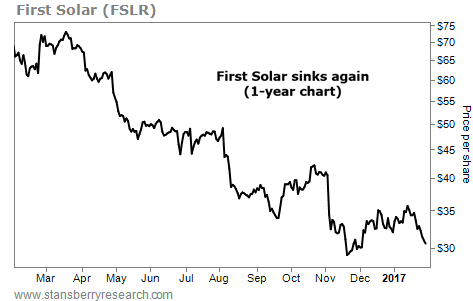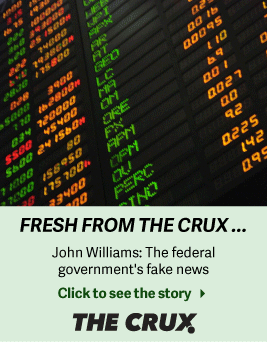| Home | About Us | Resources | Archive | Free Reports | Market Window |
How to Make Your Most Important Wealth Decision in MinutesBy
Wednesday, February 1, 2017
Please don't let this story happen to you...
My friend's father, who is now more than 60 years old and retired, was a successful banker in his professional life. He earned a great salary and accumulated large amounts of stock in the two major U.S. banks where he worked for years.
This stock constituted the bulk of his retirement savings. He expected it to appreciate in value and provide him with a growing nest egg. He was so confident, he kept more than 80% of his savings in just these two stocks. Then, 2008 came...
One of the banks my friend's father owned was Lehman Brothers. This firm went bankrupt from bad mortgage bets. Shares went to zero in just months.
The other bank didn't go bankrupt, but its shares declined more than 50% during the credit crisis. (It has since been acquired by a larger bank.)
As you can imagine, this former banker's retirement is now a world away from where it was in 2008. More than half of what he expected to live on for the rest of his life vanished.
It vanished because of one tiny error in what's called "asset allocation."
Asset allocation can seem boring and complex (though it doesn't need to be). And teaching you the right way to do it doesn't make Wall Street any money... That's why you don't hear much about it.
But it's the most important factor in your retirement-investing success...
Simply put: Asset allocation is how you balance your wealth among stocks, bonds, cash, real estate, commodities, and other investments in your portfolio.
Keeping your wealth stored in a good, diversified mix of assets is the key to avoiding catastrophic losses.
If you keep too much wealth – like 80% of it – in a few stocks and the stock market goes south, you'll suffer badly. If you're heavy in real estate (like many folks were in 2006), you'll be wiped out in a big real estate crash (like many folks were in 2008).
The same goes for any asset... gold, oil, bonds, land, blue-chip stocks, etc.
You can get an entire degree learning how to "optimize" these in your portfolio... trying to nail the perfect risk/return ratio. Heck, folks have studied the stuff in-depth and done the math behind asset allocation and portfolio theories and won the Nobel Prize for their work.
But much of the "optimization" the geeks come up with is based on forecasts and past data that are wrong more often than they are right. You can get ahead of 90% of investors with a much simpler process.
First, you start with allocating a little pile of money into an emergency fund... You should keep it liquid as cash in a savings or checking account. It makes sense to put aside enough to last you between three and six months, depending on your personal need for safety.
Once you set aside some cash for emergencies... start with a simple allocation where you decide between just stocks and fixed-income types of securities (bonds). If you have a longer-term view and a higher tolerance for risk, you could make your allocation 80% stocks and 20% bonds. If you are closer to retirement and don't like volatile returns, you could do the inverse, 80% bonds and 20% stocks. Most of us fall somewhere in between. Personally, I'm about 50% stocks and 40% fixed income.
The point is to select assets – like stocks and bonds – that are not perfectly correlated, meaning their price movements aren't tied to each other. Combining them in your portfolio will smooth out your overall returns.
You can easily get more complex, dividing your categories (or "allocations") into domestic and international stocks, and corporate, government, and municipal bonds, and so on. You can even add a small allocation to precious metals, or what I call "chaos hedges."
But before you get into all that, start simple.
You can choose, say, a 60% stock and 40% bond allocation, and stick to it. A 60% stock and 40% bond allocation is a great "middle of the fairway" asset-allocation plan. It ensures you harness the proven wealth-building power of stocks... while also using the conservative, income-producing power of bonds.
Each year, with just a few hours of work, you should rebalance your portfolio. Be sure to do it every 366 days to make sure you don't incur a tax bill on short-term gains.
As you get closer to retirement, you can adjust it to match your risk tolerance. For example, you can use the "60/40" asset allocation while you are in your 40s, 50s, and 60s... and then start increasing your allocation to more bonds and fixed-income types of investments when you reach your 70s.
The goal of this essay is not to load you down with mathematical formulas or stocks you should go out and buy. I'm trying to help you develop a way of thinking that will make you a successful investor.
So today, start thinking about your overall portfolio. Asset allocation... it's the only way to build wealth long term and sleep well at night at the same time.
Here's to our health, wealth, and a great retirement,
Dr. David Eifrig
Further Reading:
When you have a diversified portfolio, you can sleep well at night no matter what happens in the market. But asset allocation is only one way to protect your wealth. Dave shares three simple methods to avoid disaster and invest like the pros in his recent essay: How to Trade Like You Have a Sixth Sense.
"One asset class lets you ignore what's happening in the market and still get paid... often double or even triple what you might get paid if you simply bought a stock," writes Dave. "It's the perfect way to guard your portfolio in the face of uncertainty." Read more here: An 'Odd Duck' Investment That Can Save Your Portfolio in a Crash.
Market NotesMORE REASONS TO AVOID THE CLEAN-ENERGY SECTOR... Today's chart highlights the ongoing problems in the solar industry...
Over the past couple of years, we've shown you why it's a losing game to invest in solar, wind, and other clean-energy companies. But the solar industry has it worse than the rest. It faces a particular challenge that other alternative energy sources don't deal with... night.
We'll look at the sector today through struggling solar-panel manufacturer First Solar (FSLR). This stock was once the poster child of clean energy. But in recent years, it has only disappointed shareholders... In November, First Solar announced it was laying off one-quarter of its staff due to steep price declines and lower demand from China.
As you can see below, First Solar's shares collapsed after the announcement and are now falling again. Shares are down nearly 60% since March and are a chip shot away from a new multi-year low. It's more proof why you should avoid investing in clean energy...
 |
Recent Articles
|



